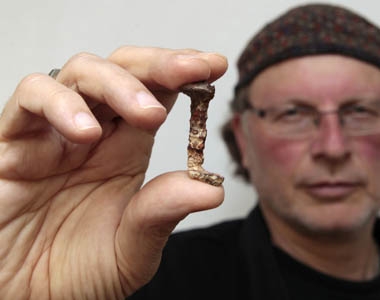Archaeologist thinks he might have found nails from Jesus’s cross
excerpts from article on washingtonpost.com
JERUSALEM — An Israeli Canadian journalist thinks he might have tracked down two of the iron nails used to crucify Jesus on the cross.
Or objects that “could be” the long-lost relics.

While researching a segment for the History Channel series “Secrets of Christianity,” host and producer Simcha Jacobovici learned something that startled him: In 1990, Israeli archaeologists excavating a 2,000-year-old burial cave found two nails crafted by Romans but kept the discovery quiet.
They did publicize the discovery of two ossuaries — stone burial boxes filled with human bones — with the inscriptions “Caiaphas” and “Joseph son of Caiaphas.” The latter intricately carved ossuary toured the world and is on display in the Israel Museum in Jerusalem.
According to the Gospels, Caiaphas was the Jewish high priest who handed Jesus over to the Romans for crucifixion.
“There’s a general scholarly consensus that the tomb where the nails were found likely belonged to Caiaphas. Nails at that time were a dime a dozen, but finding one in a tomb is exceedingly rare,” Jacobovici said outside the high stone walls of the Old City, where Jesus spent his final days.
When Jacobovici found a brief reference to the nails in the official archaeologists’ report, he said his “jaw dropped.”
“It would be as if, 2,000 years from now, archaeologists uncovered the cave of Muhammad Ali but neglected to mention the pair of boxing gloves found there. Sure, boxing gloves are common, but perhaps those particular gloves had special significance to the boxer?”
The history detective searched the Israel Antiquities Authority’s warehouses and tried to find the location of the long-sealed tomb, which now lies beneath a public park.
Finally, on a hunch, Jacobovici approached Israel Hershkovitz, a forensic anthropologist at Tel Aviv University who is an expert on crucifixions.
“When I asked Hershkovitz if he’d received two nails about 20 years ago, he knew exactly what I was talking about and located them within minutes,” Jacobovici said.
Hershkovitz could not say where the nails had been found because the original packaging lacked that information. He could not be reached for comment.
Although Hershkovitz knows for certain the nails came from the Israel Antiquities Authority, there’s no conclusive link that they came from the Caiaphas tomb. Israeli archaeologists seem as reluctant to comment this time around as in 1990.
Jacobovici is certain his research will withstand scrutiny, even if it seems circumstantial. “Skepticism is good. As with the Shroud of Turin, you can’t be 100 percent certain, but believers don’t need 100 percent certainty. They need a solid ‘could be,’ and that’s what we’re offering.”

